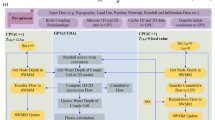Abstract
In view of the frequent occurrence of urban inundation, this paper establishes a multi-time scale non-uniform grid model that integrates a non-uniform grid division approach, local time stepping scheme and Graphics Processing Unit (GPU) parallel technology to improve computational efficiency. The Harten-Lax-vanLeer-Contact (HLLC) approximate Riemann solution is adopted to estimate interface fluxes, the Monotonie Upwind Scheme for Conservation Laws (MUSUL) and Runge–Kutta methods are adopted to achieve second-order accuracy in time and space. Each grid uses the time step allowed locally to update variables. The results show that the proposed model has certain accuracy and greatly improves the calculation efficiency. When the threshold for grid density is 30%-45% of the average topographic gradient change, the accuracy and the efficiency are optimized in simulation of urban inundation. At this time, the average error of inundation area is about 6.05%, and the simulated speed of the proposed model is about 4.52 times that of the traditional uniform grid model. Therefore, the proposed model has a certain promotion value in large-scale shallow water flow simulations.







Similar content being viewed by others
Availability of Data and Materials
The data and code that support the study are available from the corresponding author upon reasonable request.
References
Alehu BA, Bitana SG (2023) Assessment of climate change impact on water balance of Lake Hawassa Catchment. Environ Process 10(1):14. https://doi.org/10.1007/s40710-023-00626-x
Crossley AJ, Wright NG, Whitlow CD (2003) Local time stepping for modeling open channel flows. J Hydraul Eng 129(6):455–462. https://doi.org/10.1061/(ASCE)0733-9429(2003)129:6(455)
Dazzi S, Maranzoni A, Mignosa P (2016) Local time stepping applied to mixed flow modeling. J Hydraul Res 54(2):145–157. https://doi.org/10.1080/00221686.2015.1132276
Gao J, Murao O, Pei X, Dong Y (2022) Identifying evacuation needs and resources based on volunteered geographic information: a case of the rainstorm in July 2021, Zhengzhou, China. Int J Environ Res Public Health 19(23):16051. https://doi.org/10.3390/ijerph192316051
Hou J, Guo K, Wang Z et al (2017) Numerical simulation of the impact of designed heavy rain patterns on urban waterlogging. Adv Water Sci 28(06):820–828. https://doi.org/10.14042/j.cnki.32.1309.2017.06.003
Hou J, Liang Q, Zhang H, Hinkelmann R (2015) An efficient unstructured MCJSCL scheme for solving the 2D shallow water equations. Environ Model Softw 66:131–152. https://doi.org/10.1016/j.envsoft.2014.12.007
Kim S, Shen H, Noh S, Seo D, Welles E, Pelgrim E, Weerts A, Lyons E, Philips B (2021) High-resolution modeling and prediction of urban floods using WRF-Hydro and data assimilation. J Hydrol 598:126236. https://doi.org/10.1016/j.jhydrol.2021.126236
Liang Q (2011) A structured but non-uniform Cartesian grid-based model for the shallow water equations. Int J Numer Meth Fluids 66(5):537–554. https://doi.org/10.1002/fld.2266
Montenegro M, Mendoza D, Mora D, García F, Avilés A (2022) Extreme rainfall variations under climate change scenarios. Case of study in an Andean Tropical River Basin. Water Resour Manag 36(15):5931–5944. https://doi.org/10.1007/s11269-022-03332-9
Ni Y, Cao Z, Liu Q, Liu Q (2020) A 2D hydrodynamic model for shallow water flows with significant infiltration losses. Hydrol Process 34(10):2263–2280. https://doi.org/10.1002/hyp.13722
Petti M, Bosa S (2007) Accurate shock-capturing finite volume method for advection-dominated flow and pollution transport. Comput Fluids 36(2):455–466. https://doi.org/10.1016/j.compfluid.2005.11.008
Rangari VA, Umamahesh NV, Patel AK (2021) Flood-hazard risk classification and mapping for urban catchment under different climate change scenarios: A case study of Hyderabad city. Urban Climate 36(2015):100793. https://doi.org/10.1016/j.uclim.2021.100793
Sanders BF (2008) Integration of a shallow water model with a local time step. J Hydraul Res 46(4):466–475. https://doi.org/10.3826/jhr.2008.3243
Sattari MT, Avram A, Apaydin H, Matei O (2023) Evaluation of feature selection methods in estimation of precipitation based on deep learning artificial neural networks. Water Resour Manag 37(10):5871–6589. https://doi.org/10.1007/s11269-023-03563-4
Wang J, Hou J, Gong J, Li B, Shi B, Guo M, Shen J, Lu P (2021) A non-uniform grid approach for high-resolution flood inundation simulation based on GPUs. J Hydrodyn 33:844–860. https://doi.org/10.1007/s42241-021-0060-6
Funding
This work is supported by the Natural Science Foundation of Tianjin (No. 22JCQNJC00660) and the National Natural Science Foundation of China (Grant No. 52201333).
Author information
Authors and Affiliations
Contributions
Conceptualization and Methodology: S. Li, J. Wang, J. Hou; Writing-original draft preparation: J. Wang; Material preparation, collection and analysis: Y. Liu, W. Hu; Supervision: X. Shi, J. Yao; Funding acquisition: S. Li.
Corresponding authors
Ethics declarations
Ethical Approval
Informed consent.
Consent to Participate
Not applicable.
Consent to Publish
The authors are indeed informed and agree to publish.
Competing Interests
None.
Additional information
Publisher's Note
Springer Nature remains neutral with regard to jurisdictional claims in published maps and institutional affiliations.
Rights and permissions
Springer Nature or its licensor (e.g. a society or other partner) holds exclusive rights to this article under a publishing agreement with the author(s) or other rightsholder(s); author self-archiving of the accepted manuscript version of this article is solely governed by the terms of such publishing agreement and applicable law.
About this article
Cite this article
Wang, J., Li, S., Hou, J. et al. Study on Multi-Time Scale Hydrodynamic Model Based on Local Time Stepping Scheme and GPUs and its Application in Urban Inundation. Water Resour Manage 38, 1615–1637 (2024). https://doi.org/10.1007/s11269-024-03742-x
Received:
Accepted:
Published:
Issue Date:
DOI: https://doi.org/10.1007/s11269-024-03742-x




